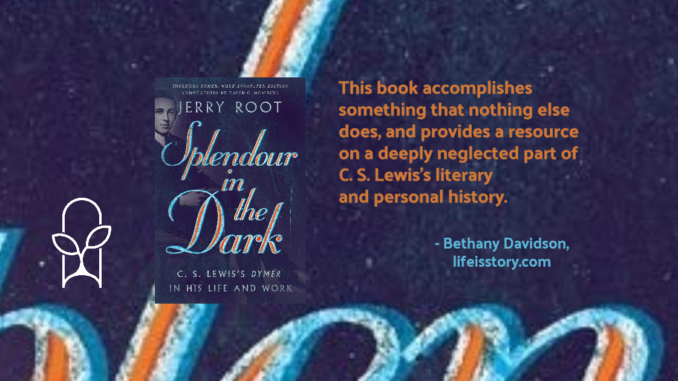
Series: Hansen Lectureship #3
Published by IVP Academic on November 3, 2020
Genres: Academic, Non-Fiction, Christian Life, Theology
Buy on Amazon
Goodreads

Several years before he converted to Christianity, C. S. Lewis published a narrative poem, Dymer, under the pseudonym Clive Hamilton. Later, of course, Lewis became well known for his beloved imaginative stories, such as The Chronicles of Narnia and Till We Have Faces, as well as his ability to defend and articulate the faith in works such as Mere Christianity. But what about his literary work before his conversion? In this fourth volume in the Hansen Lectureship Series, Jerry Root contends that Lewis's early poem Dymer can not only shed light on the development of Lewis's literary skills but also offer a glimpse of what was to come in his intellectual and spiritual growth--a "splendour in the dark," to borrow one of Lewis's own lines from the poem. Under Root's careful analysis, Dymer becomes a way to understand both Lewis's change of mind as well as the way in which each of us is led on a journey of faith. This volume also includes the complete text of Dymer with annotations from David C. Downing, co-director of the Marion E. Wade Center. The Hansen Lectureship series offers accessible and insightful reflections by Wheaton College faculty members upon the transformative work of the Wade Center authors.
Even though I am a lifelong C.S. Lewis fan, I was not aware of his published narrative poem, Dymer, until I started reading his collected journals from the 1920s. He wrote regularly then about how the poem was coming along, and even though my reading and interpretation skills for epic poetry are very limited, I thought that it would be interesting to read this pre-conversion work from my favorite author. When I learned about Splendour in the Dark: C. S. Lewis’s Dymer in His Life and Work, I knew that this was the perfect opportunity. The first half of the book reprints the poem in a version annotated by David C. Downing, and the second half explores the poem’s themes and foreshadowing for Lewis’s future writings. Reading Dymer this way, with annotations and following analysis, I was able to get far more out of it than I could have otherwise.
Scholarly Insight and Readers’ Perspectives
Jerry Root delivered a series of lectures about Dymer at Wheaton College, and this book collects his scholarly insights into three chapters. At the end of each chapter, Root also includes a reader response essay from other writers. They each come from different backgrounds and write about Dymer from their unique perspectives, engaging with both the text and Root’s analysis. My favorite of the essays comes from Miho Nonaka, who writes some about her experience originally reading The Lion, the Witch, and the Wardrobe in a Japanese translation. I enjoyed all of the different perspectives, and think that they provide great balance to Root’s expert view of the work. Personally, I agree with the other respondents that Dymer has languished in obscurity for a reason, and that even though Jerry Root sees literary merit in it, it feels rushed, incomplete, and unsatisfying to the average reader.
However, just like the respondents, I thoroughly agree with Root’s interesting perspective into why Dymer is significant for understanding Lewis’s development as a writer. It intrigued me to see how frequently the poem references Bible verses, given that Lewis was an avowed atheist at the time that he wrote it, and the story of Dymer’s search for meaning and struggle against illusions reflects Lewis’s spiritual journey in many ways. Root draws parallels between the major themes of Dymer and some of Lewis’s later works, showing how he was later able to better understand and present his ideas through the lens of Christianity. Lewis’s epic poem reflects his youthful stage of life and struggle with disappointment against competing ideals that could not stand up against reality, and in this sense, some of his later works serve as an answer to Dymer, amplifying its themes with Lewis’s mature, converted worldview.
For Understanding Lewis
This book also includes Lewis’s preface to the 1950 edition of Dymer. He wrote that the idea of “disturbing its repose in the grave” came from the publishers, not him, and focused on clarifying potential areas of confusion and misinterpretation. Jerry Root analyzes this preface along with the work, and also draws on letters and other documentary evidence to provide insight on what Lewis thought and believed about this poem, both at the time of its writing and afterwards. Root never commit the error of attributing everything about a character to the author, and acknowledges how much it disturbed Lewis when people tried to read into an author’s mind and motives instead of engaging directly with a work, but he draws solid parallels between Dymer’s disillusionment and the frustration that the young Lewis faced.
I found this book fascinating, and even though the book will only be of interest to major fans of Lewis and literary scholars, I would recommend this to anyone who is interested in exploring this obscure work of Lewis’s, or who wants a more complete sense of his oeuvre, development as a writer, and primary thematic emphases. Part of the reason why I am giving this book five stars is because it accomplishes something that nothing else does, and provides a resource on a deeply neglected subject. I hope that this book will inspire future Lewis biographers and literary critics to pay more attention to this neglected work, since it has such strong implications for understanding Lewis’s development as a writer.



